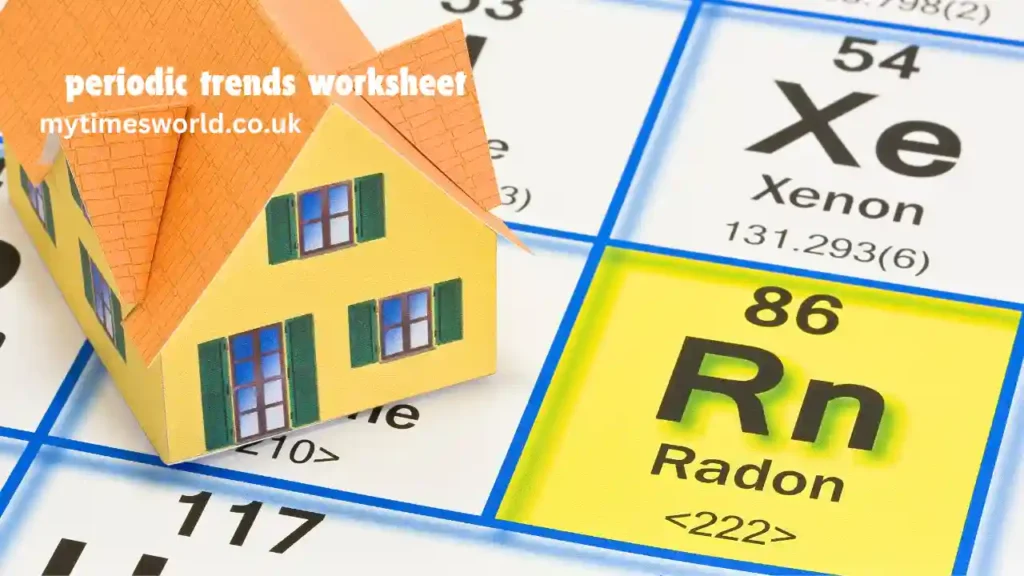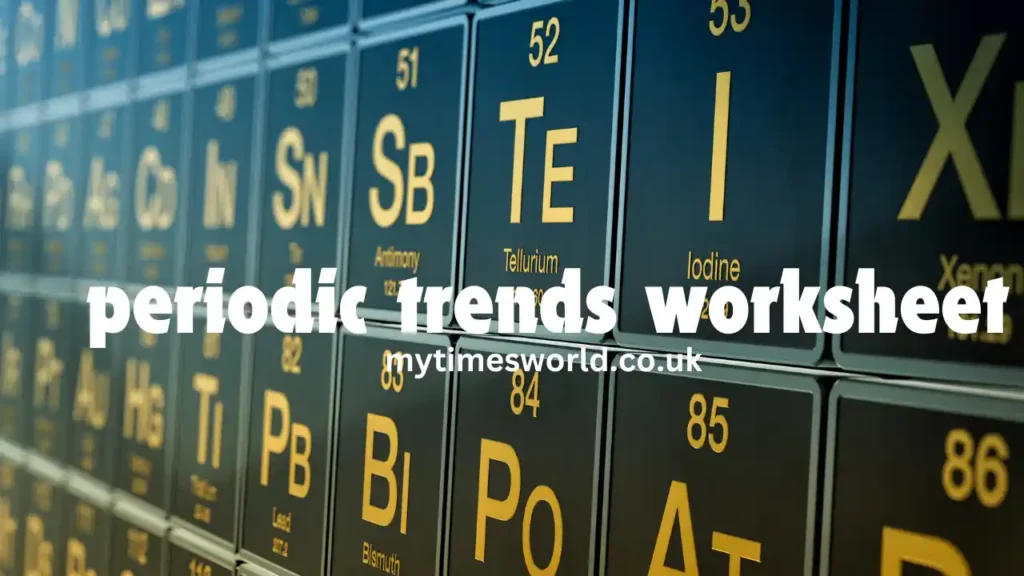What Are Periodic Trends?
Before diving into the specific trends, let’s quickly define periodic trends. These are patterns seen in the properties of elements across the periodic table. The periodic table is arranged in increasing atomic number (number of protons in an atom), but there’s more to it than just that.
As you move across a period (horizontal row) or down a group (vertical column) in the table, certain properties of elements change in predictable ways. These are called periodic trends. By understanding these trends, you can make educated guesses about how different elements will behave.
The Major Periodic Trends:
Atomic Radius
Ionization Energy
Electronegativity
Electron Affinity
Metallic Character
Let’s explore each one.
Atomic Radius
What is Atomic Radius?
The atomic radius is the distance from the center of an atom’s nucleus to its outermost electron. Think of it as how big the atom is.
Trend Across a Period:
As you move from left to right across a period, the atomic radius decreases. This might seem strange at first because you are adding more protons and electrons as you move across a period. However, the increased number of protons pulls the electrons closer to the nucleus, making the atom smaller.
- Example: The atomic radius of Sodium (Na) is larger than Chlorine (Cl).
Trend Down a Group:
As you move down a group, the atomic radius increases. This is because, as you move down a group, more electron shells are added, making the atom larger.
- Example: Potassium (K) has a larger atomic radius than Sodium (Na).
Ionization Energy
What is Ionization Energy?
Ionization energy is the amount of energy required to remove an electron from a neutral atom. The higher the ionization energy, the more difficult it is to remove an electron.
Trend Across a Period:
As you move from left to right across a period, the ionization energy increases. This is because atoms on the right side of the periodic table hold onto their electrons more tightly due to the increased number of protons in the nucleus.
- Example: Fluorine (F) has a higher ionization energy than Lithium (Li).
Trend Down a Group:

As you move down a group, the ionization energy decreases. This happens because, as the atomic radius increases, the outer electrons are farther from the nucleus and are therefore easier to remove.
- Example: Cesium (Cs) has a lower ionization energy than Sodium (Na).
Electronegativity
What is Electronegativity?
Electronegativity is a measure of how strongly an atom attracts electrons in a chemical bond. The higher the electronegativity, the more an atom will pull electrons toward itself.
Trend Across a Period:
As you move from left to right across a period, electronegativity increases. This is because atoms on the right side of the periodic table, especially nonmetals, want to gain electrons to complete their outer shell.
- Example: Oxygen (O) is more electronegative than Boron (B).
Trend Down a Group:
As you move down a group, electronegativity decreases. The larger atomic radius means the nucleus has a weaker pull on electrons.
- Example: Fluorine (F) is more electronegative than Iodine (I).
Electron Affinity
What is Electron Affinity?
Electron affinity refers to the amount of energy released when an atom gains an electron. Atoms with high electron affinity are more likely to accept electrons.
Trend Across a Period:
As you move from left to right across a period, electron affinity generally increases. Nonmetals, in particular, are eager to gain electrons to fill their outer shells.
- Example: Chlorine (Cl) has a higher electron affinity than Sodium (Na).
Trend Down a Group:
As you move down a group, electron affinity generally decreases. Larger atoms have less attraction for additional electrons.
- Example: Fluorine (F) has a higher electron affinity than Bromine (Br).
Metallic Character
What is Metallic Character?
Metallic character refers to how much an element behaves like a metal. Metals are good conductors of heat and electricity, have luster, and tend to lose electrons in chemical reactions.
Trend Across a Period:
As you move from left to right across a period, metallic character decreases. Nonmetals are on the right side of the periodic table, and they tend to gain electrons rather than lose them.
- Example: Magnesium (Mg) is more metallic than Sulfur (S).
Trend Down a Group:
As you move down a group, metallic character increases. Atoms get larger, and their outer electrons are more easily lost, making them behave more like metals.
- Example: Francium (Fr) has more metallic character than Lithium (Li).
Worksheet: Practice with Periodic Trends

Now that we’ve covered the basics of periodic trends, it’s time to put that knowledge into practice. Below is a worksheet with questions designed to reinforce your understanding of periodic trends. Feel free to use this as a guide to test your knowledge.
Periodic Trends Worksheet Questions:
1. Atomic Radius Questions:
- Arrange the following elements in order of increasing atomic radius: Li, Na, K, Rb.
- Which has a larger atomic radius: Aluminum (Al) or Chlorine (Cl)? Explain why.
2. Ionization Energy Questions:
- Place the following elements in order of increasing ionization energy: Mg, Si, S, Ar.
- Why does Helium (He) have the highest ionization energy?
3. Electronegativity Questions:
- Which element is more electronegative: Nitrogen (N) or Phosphorus (P)? Why?
- Explain why Fluorine (F) has the highest electronegativity on the periodic table.
4. Electron Affinity Questions:
- Arrange the following elements in order of increasing electron affinity: C, O, F, N.
- Why does Chlorine (Cl) have a higher electron affinity than Sodium (Na)?
5. Metallic Character Questions:
- Rank the following elements in terms of increasing metallic character: Na, Cs, K.
- Which has more metallic character: Calcium (Ca) or Boron (B)?
Worksheet Answer Key:
1. Atomic Radius Answers:
- Increasing atomic radius: Li < Na < K < Rb
- Aluminum (Al) has a larger atomic radius than Chlorine (Cl) because as you move from left to right across a period, the atomic radius decreases.
2. Ionization Energy Answers:
- Increasing ionization energy: Mg < Si < S < Ar
- Helium (He) has the highest ionization energy because it has a very small atomic radius and its electrons are very close to the nucleus, making them harder to remove.
3. Electronegativity Answers:
- Nitrogen (N) is more electronegative than Phosphorus (P) because electronegativity decreases as you move down a group.
- Fluorine (F) has the highest electronegativity due to its small size and high effective nuclear charge.
4. Electron Affinity Answers:
- Increasing electron affinity: N < C < O < F
- Chlorine (Cl) has a higher electron affinity than Sodium (Na) because nonmetals tend to gain electrons more easily.
5. Metallic Character Answers:
- Increasing metallic character: Na < K < Cs
- Calcium (Ca) has more metallic character than Boron (B) because it is a metal, while boron is a metalloid.
Conclusion:
Understanding periodic trends is crucial for anyone studying chemistry, as they allow us to predict how different elements will behave based on their position in the periodic table. By mastering concepts like atomic radius, ionization energy, electronegativity, electron affinity, and metallic character, you can better understand the relationships between elements.
This blog post, along with the provided worksheet, should help solidify your grasp of periodic trends. Feel free to revisit this guide whenever you need a refresher on these important concepts!







Be First to Comment